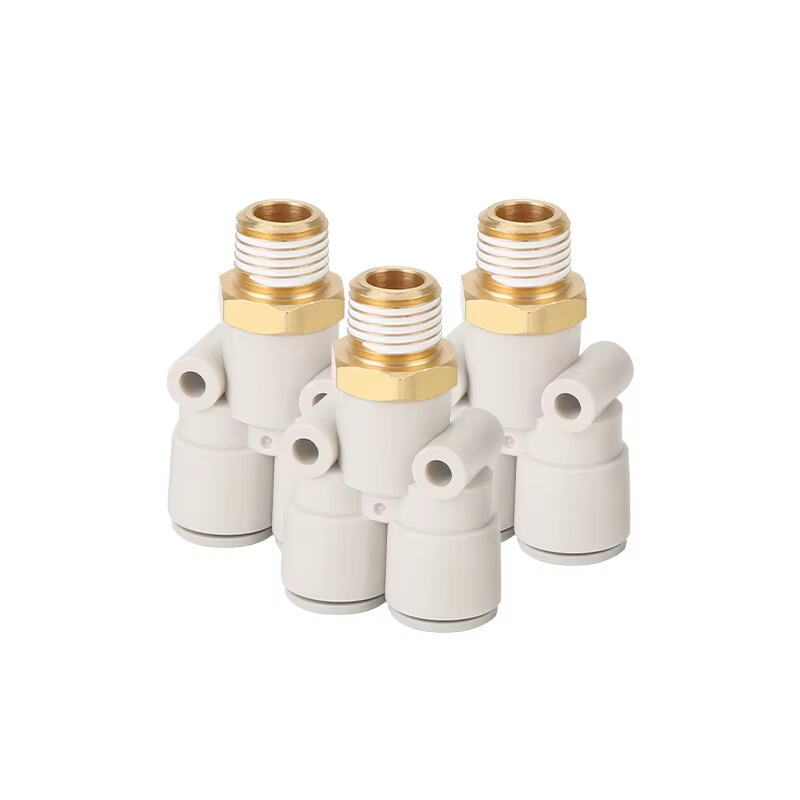Introducción: ¿Pueden Sus Conectores Neumáticos Soportar la Prueba de Condiciones Extremas?
En el exigente mundo de la automatización y la fabricación industrial, el aire comprimido es el soporte fundamental de la productividad. Sin embargo, este sistema vital es tan fuerte como su punto más débil: la conexión . Un fallo en este lugar, ya sea una fuga, una ruptura o una brecha por contaminación, puede desencadenar una cascada de consecuencias: costosas paradas no planificadas, calidad de producto comprometida e incluso riesgos de seguridad. De hecho, estudios del sector sugieren que las fugas representan el 20-30% del aire comprimido generado , lo que supone una importante y silenciosa pérdida de rentabilidad.
Elegir el conector neumático adecuado no es solo una decisión de compra; es una inversión estratégica fundamental en la fiabilidad y eficiencia de su operación. Pero con un mercado global saturado de opciones, desde marcas premium europeas hasta fabricantes asiáticos más económicos, ¿cómo puede discernir cuáles son realmente capaces de cumplir con sus promesas de calidad y durabilidad?
Esta guía definitiva traspasa el ruido. Exploraremos las marcas líderes mundiales de conectores neumáticos, analizaremos lo que realmente las distingue y le proporcionaremos un marco claro y accionable para seleccionar los conectores perfectos para sus entornos más exigentes. Al final de este artículo, estará equipado con el conocimiento necesario para optimizar el rendimiento de su sistema neumático, reducir su costo total de propiedad y tomar una decisión de compra segura.
Por qué: El papel crítico de los conectores neumáticos de alta calidad
Más que un simple enlace: El conector como componente del sistema
A menudo se subestima a los conectores neumáticos como simples productos básicos. En realidad, son componentes fabricados con precisión que influyen directamente en tres pilares fundamentales de su operación:
-
Integridad del sistema y tiempo de actividad:
Prevención de fugas: Un solo conector mal fabricado puede perder litros de aire comprimido por minuto. Los conectores de alta calidad presentan hilos mecanizados con precisión, superficies de sellado superiores (por ejemplo, metal con metal con anillos O integrados) y materiales de sellado resistentes que mantienen su integridad bajo ciclos de presión y vibración.
Eficiencia de flujo: El diámetro interno y el diseño de un conector impactan directamente en el flujo de aire y la caída de presión. Las marcas premium diseñan sus conectores para mínima restricción del flujo , asegurando que sus cilindros y herramientas reciban toda la potencia para la que fueron diseñados.
-
Seguridad y mitigación de riesgos:
En entornos exigentes como plantas químicas, procesamiento de alimentos o minería, el fallo de un conector puede ser catastrófico. Las marcas de alta calidad diseñan y prueban sus productos para que resistan presiones extremas, temperaturas elevadas y sustancias corrosivas, protegiendo tanto al personal como al equipo.
-
Costo Total de Propiedad (TCO):
Aunque los conectores premium tienen un costo inicial más alto, su tCO a largo plazo es significativamente menor . Tienen una vida útil más larga, requieren menos mantenimiento, evitan el desperdicio costoso de energía debido a fugas y eliminan el tiempo de inactividad y los costos laborales asociados con reemplazos frecuentes.
Qué: Definir la Excelencia en Conectores Neumáticos
¿Qué es un Conector Neumático? Una Definición Amplia
Un conector neumático es un término general para cualquier dispositivo utilizado para unir secciones de tubería neumática, manguera o tubo a otros componentes como válvulas, cilindros o herramientas. Esta categoría incluye:
Acoples Rápidos: Para herramientas y aplicaciones de desconexión fácil.
Accesorios de Empuje para Conectar: Para instalación rápida sin herramientas en tubos.
Conexiones con Barbilla: Para usarse con abrazaderas en mangueras flexibles.
Fittings de compresión: Para un sellado seguro y permanente en tubos.
Adaptadores con Rosca (NPT, BSPP, BSPT): Para conectarse a puertos con rosca.
Las Características de una Marca de Alta Gama
¿Qué diferencia a un líder del mercado de un proveedor genérico? Busque estos atributos:
Inversión en Ingeniería e I+D: Las marcas líderes innovan continuamente en ciencia de materiales y diseño, utilizando CFD (Dinámica de Fluidos Computacional) para optimizar el flujo de aire y FEA (Análisis por Elementos Finitos) para garantizar la integridad estructural.
-
Normas Rigurosas de Materiales:
El cobre: No todo el latón es igual. Las marcas premium utilizan latón sin plomo y resistente a la desincificación (DZR) para una mayor resistencia a la corrosión, especialmente importante en entornos húmedos.
Acero inoxidable: Los grados 303 y 316L son comunes, siendo el 316L el que ofrece una excelente resistencia a productos químicos y agua salada.
Plásticos: Polímeros de alto rendimiento como el PPS (Sulfuro de Polifenileno) y el PEEK se utilizan por su ligereza, resistencia química y resistencia mecánica.
Fabricación de precisión: La consistencia es fundamental. Los principales fabricantes utilizan mecanizado CNC con tolerancias estrictas, control automático de calidad y pruebas de presión al 100% para garantizar que cada pieza que sale de la fábrica sea perfecta.
-
Certificaciones integrales: Busque certificaciones relevantes para su industria:
ISO 9001: Sistemas de Gestión de Calidad.
ATEX / IECEx: Para uso en atmósferas explosivas.
FDA/USP Clase VI: Para materiales seguros en aplicaciones alimentarias, bebidas y farmacéuticas.
WRAS: Esquema Asesor de Regulaciones del Agua del Reino Unido (para agua y aire).
Cómo: Cómo evaluar y seleccionar la mejor marca para sus necesidades
Un marco de selección de 5 pasos
Navegar por el panorama de marcas requiere un enfoque estructurado.
-
Audita tu Aplicación demanda:
Entorno: ¿Es un área estándar de fábrica, un área de lavado (IP67/IP69K), químicamente corrosiva o explosiva (ATEX)?
Presión y Temperatura: ¿Cuáles son tus PSI/bar y °C/°F máximos y de operación? Siempre especifica un conector clasificado para por encima tu presión máxima de operación.
Medio: ¿Es solo aire limpio? ¿O contiene lubricante (aire aceitoso), humedad u otras sustancias químicas?
-
Comprende tus prioridades de rendimiento:
Clasifica estos elementos por orden de importancia: Costo (inicial frente a a largo plazo), Rendimiento (caída de presión mínima), Durabilidad (vida útil del ciclo), Facilidad de instalación (tiempo de mantenimiento).
-
Investiga y selecciona marcas:
-
Categoría Global Principal (Los líderes establecidos):
Legris (por Parker): Un pionero en tecnología push-to-connect, reconocido por innovación, calidad y una amplia gama de productos. De uso frecuente en automatización de alta gama.
Festo: Sinónimo de excelencia en ingeniería alemana. Ofrece una gama extremadamente amplia de conectores y componentes de automatización de alto rendimiento y confiables.
SMC Corporation: Un gigante japonés que ofrece un portafolio enorme de productos de alta calidad y confiabilidad, con una fuerte presencia y red de soporte global.
Parker Hannifin: Un líder estadounidense conocido por su extrema durabilidad y rendimiento en entornos adversos. Sus productos suelen ser referentes en la industria.
-
Marca de Alto Valor (Calidad con Precio Competitivo):
Marcas como la nuestra: Muchos fabricantes, incluida nuestra empresa, han invertido fuertemente para alcanzar una calidad equiparable a las marcas líderes, ofreciendo al mismo tiempo una relación calidad-precio significativamente mejor, entregas más rápidas y opciones de personalización más flexibles. Cumplimos con estándares internacionales y a menudo los superamos en aplicaciones específicas.
-
-
Solicite y Pruebe Muestras:
Cualquier marca reputada proporcionará muestras gratuitas. ¡Pruebelos! Realice una prueba de decaimiento de presión, verifique la sensación de los hilos y el engranaje, y sométalos a una simulación en condiciones reales en sus instalaciones.
-
Evalúe al proveedor, no solo al producto:
Soporte técnico: ¿Pueden proporcionar asesoramiento experto?
Plazos de entrega y disponibilidad: ¿Está disponible el stock rápidamente?
Personalización: ¿Pueden ofrecer soluciones personalizadas?
Ventajas y desventajas: una mirada objetiva al panorama de marcas
| Categoría de marca | Ventajas | Desventajas |
|---|---|---|
| Principales globales (por ejemplo, Festo, SMC, Parker) |
Reconocimiento único de marca: Historial demostrado en aplicaciones extremas. I+D extensa: Innovación de vanguardia. Soporte y disponibilidad globales: Amplias redes de distribución. Gama de Productos Completa: Tienda integral para todas las necesidades neumáticas. |
Precio Premium: Costo inicial significativamente más alto. Menos flexibilidad: Los productos estándar pueden no adaptarse a necesidades únicas. Potencial de plazos más largos en artículos especializados. |
| Alto valor / Especialista (por ejemplo, Nuestra marca) |
Excelente valor: Alta calidad a un precio más competitivo. Ágil y receptivo: Plazos de entrega más rápidos y mayor disposición para personalizar. Relación directa: A menudo ofrece un acceso más directo al soporte técnico de ingeniería. Experiencia enfocada: Puede destacar en nichos específicos. |
Huella Global Menor: Puede tener menos distribuidores locales. Prestigio de Marca: Carece de reconocimiento inmediato de un nombre global con décadas de antigüedad. Amplitud del Portafolio: El rango puede no ser tan amplio como el de los principales actores. |
| Genérico/De Bajo Costo | Costo Inicial Muy Bajo. |
Alto Riesgo: Calidad inconsistente, mayores tasas de falla. Alto costo total de propiedad (TCO): Propenso a fugas, fallos y reemplazos frecuentes. Sin soporte técnico. Posible responsabilidad en cuanto a seguridad. |
Veredicto: Para aplicaciones críticas donde el fallo no es una opción, las principales marcas globales representan una apuesta segura, aunque costosa. Sin embargo, para la gran mayoría de aplicaciones industriales, las marcas de alto valor ofrecen el equilibrio óptimo entre calidad comprobada, confiabilidad y rentabilidad, proporcionando a menudo un retorno superior sobre la inversión.

